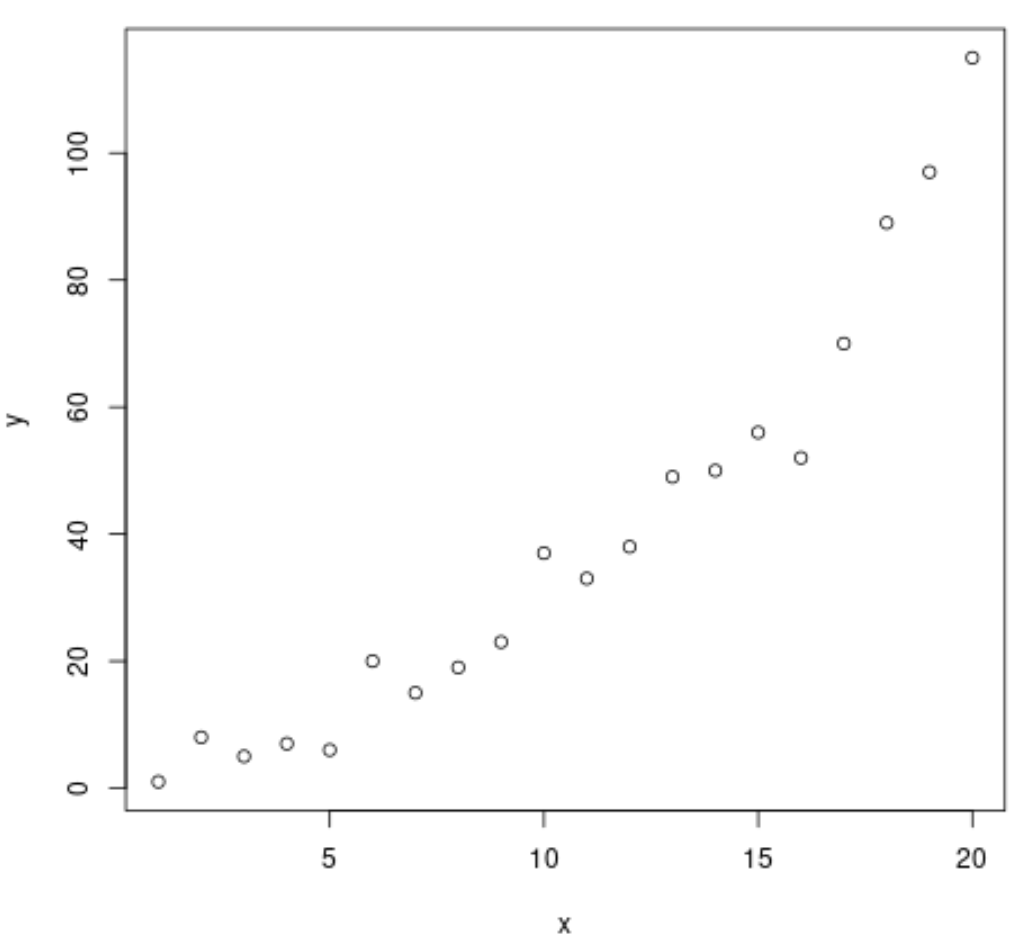Power regression is a type of non-linear regression that takes on the following form:
y = axb
where:
- y: The response variable
- x: The predictor variable
- a, b: The regression coefficients that describe the relationship between x and y
This type of regression is used to model situations where the response variable is equal to the predictor variable raised to a power.
The following step-by-step example shows how to perform power regression for a given dataset in R.
Step 1: Create the Data
First, let’s create some fake data for two variables: x and y.
#create data
x=1:20
y=c(1, 8, 5, 7, 6, 20, 15, 19, 23, 37, 33, 38, 49, 50, 56, 52, 70, 89, 97, 115)
Step 2: Visualize the Data
Next, let’s create a scatterplot to visualize the relationship between x and y:
#create scatterplot
plot(x, y)
From the plot we can see that there exists a clear power relationship between the two variables. Thus, it seems like a good idea to fit a power regression equation to the data instead of a linear regression model.
Step 3: Fit the Power Regression Model
Next, we’ll use the lm() function to fit a regression model to the data, specifying that R should use the log of the response variable and the log of the predictor variable when fitting the model:
#fit the model
model #view the output of the model
summary(model)
Call:
lm(formula = log(y) ~ log(x))
Residuals:
Min 1Q Median 3Q Max
-0.67014 -0.17190 -0.05341 0.16343 0.93186
Coefficients:
Estimate Std. Error t value Pr(>|t|)
(Intercept) 0.15333 0.20332 0.754 0.461
log(x) 1.43439 0.08996 15.945 4.62e-12 ***
---
Signif. codes: 0 ‘***’ 0.001 ‘**’ 0.01 ‘*’ 0.05 ‘.’ 0.1 ‘ ’ 1
Residual standard error: 0.3187 on 18 degrees of freedom
Multiple R-squared: 0.9339, Adjusted R-squared: 0.9302
F-statistic: 254.2 on 1 and 18 DF, p-value: 4.619e-12
The overall F-value of the model is 252.1 and the corresponding p-value is extremely small (4.619e-12), which indicates that the model as a whole is useful.
Using the coefficients from the output table, we can see that the fitted power regression equation is:
ln(y) = 0.15333 + 1.43439ln(x)
Applying e to both sides, we can rewrite the equation as:
- y = e 0.15333 + 1.43439ln(x)
- y = 1.1657x1.43439
We can use this equation to predict the response variable, y, based on the value of the predictor variable, x.
For example, if x = 12, then we would predict that y would be 41.167:
y = 1.1657(12)1.43439 = 41.167
Bonus: Feel free to use this online Power Regression Calculator to automatically compute the power regression equation for a given predictor and response variable.
Additional Resources
How to Perform Multiple Linear Regression in R
How to Perform Exponential Regression in R
How to Perform Logarithmic Regression in R



